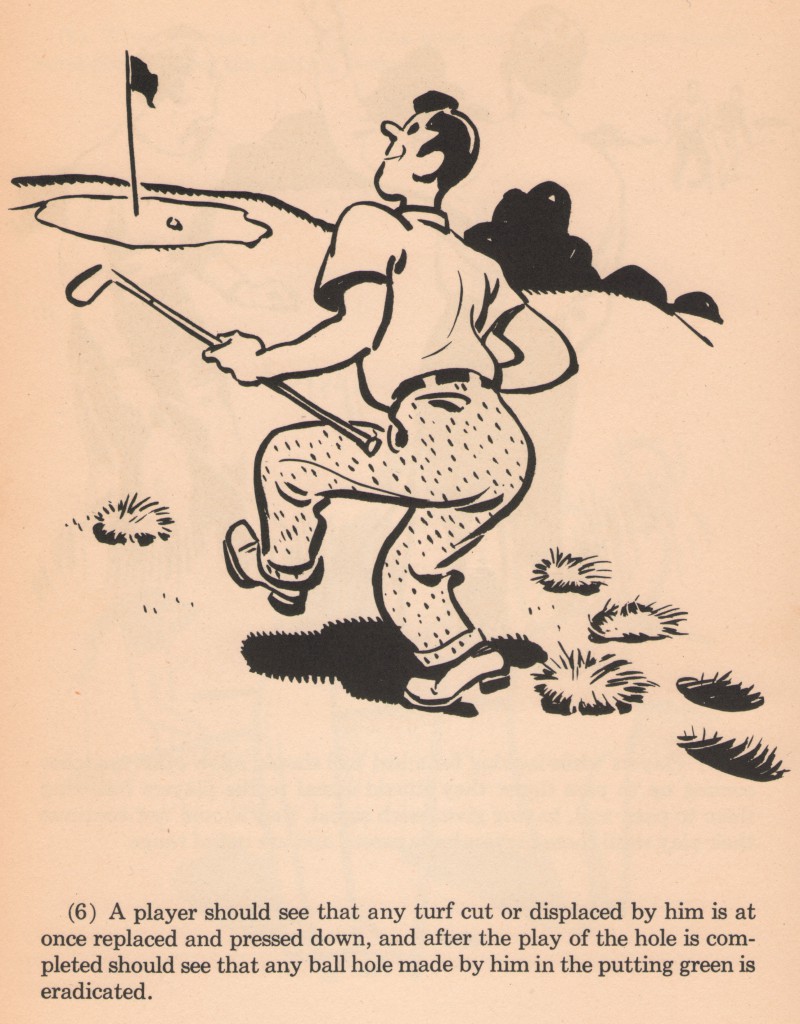
how can i buy provigil online Divot-replacement advice from “The Rules of Golf Illustrated and Explained,” edited by Francis Ouimet, 1948.
A few days ago, I pointed out that golfers use the word “divot” to mean both a chunk of turf and the hole the chunk leaves behind. I received a long, thoughtful comment from John H. Jones, who is a professor of English at Jacksonville State University, in Jacksonville, Alabama. (He’s also the author of a book about William Blake, which will be the inaugural selection of the Sunday Morning Group’s book club, if we ever start one.) A couple of days later, he sent another comment, which I’ve reproduced below.
I asked Jones to tell me something about himself, and in an email he wrote, “I started playing golf when I was about fifteen, after it became unavoidably obvious that a career as a wide receiver in the NFL was out of the question.” He knocked off for graduate school, and didn’t play again for twenty-five years. “Then for some unknown reason, during the summer before last, I decided to pick up a golf club and give it another try.” Now he’s hooked. Anyway, here are his further thoughts about divots:
Looking back at the OED [Oxford English Dictionary] information about the usage of “divot,” I kept thinking that the first usage of the term meaning “a piece of turf cut out with a club” appearing in 1886 seemed awfully late, given the long history of golf. Of course, the game takes off and gets a great deal of publicity in the second half of the nineteenth century, but still, the written use of “divot” as a “slice of turf” goes back to the sixteenth century. Surely, I thought, the golf application must have come much sooner than 1886.
A little more research took me to Peter Davies’s “The Historical Dictionary of Golfing Terms: From 1500 to the Present” (2005), where I found no better historical information for the first usage of “divot” in golf. Davies’s first notice of “divot” is also by [Horace] Hutchinson, coming in the 1890 publication “Badminton Guide to Golf,” where he says, “No golfer is worthy of the name who does not put back his divot” (260), the same year and probably the same publication as the OED’s reference to Hutchinson in 1890. And it also conveys the same sentiment.
But I still had a difficult time believing that “divot” as a piece of turf cut by a golf club did not find its way into writing until that late nineteenth century. That may very well be the case, though, because a random look at other golf terms in the OED puts “mashie” and “dormy” in the same time period. “Putter” appears about a hundred years earlier. I suspect a more thorough examination would find most golf terms finding their way into writing around the same time.
One additional piece of information appears in Davies, however. He gives a second definition for “divot” as “the cavity left by the divot,” and the first usage he notes is very recent, appearing in 1969 in “The Greatest Game of All,” where Jack Nicklaus writes that a ball “ended up in a shallow fairway divot” (160).
I wonder if the fact that the “divot” as cavity definition comes nearly eighty years after “divot” as a slice of turf suggests that instead of heeding Hutchinson, golfers over time gradually became more careless about replacing the slices of turf they cut with their clubs, so a new definition was needed.
Here’s another thought: early golfers probably didn’t take a lot of divots, since they used flat swings, wooden clubs, and crummy balls, and when they did take divots the gouges were probably hard to distinguish from existing features of the cow pastures they played in. So maybe divot replacement is a modern development, and is mainly the product of late-nineteenth-century innovations in golf equipment, swing technique, and lawn-mowing. I also think it’s sort of interesting that Francis Ouimet doesn’t use the word “divot” on the page I reproduced at the top of this post.
